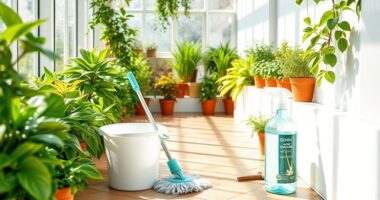To winterize your greenhouse, start by checking and upgrading your ventilation systems to prevent moisture buildup and guarantee proper airflow. Seal gaps around doors, windows, and vents to keep drafts out and maintain stable temperatures. Install pest screens and remove debris to deter pests. Good insulation plus proper sealing make your structure more resilient during cold months. If you want to learn more about specific steps, keep exploring for detailed tips to protect your greenhouse through winter.
Key Takeaways
- Ensure proper sealing of doors, windows, and vents to prevent drafts and heat loss.
- Upgrade or install adjustable, winter-rated ventilation systems to manage moisture and airflow.
- Insulate the greenhouse structure with appropriate materials to maintain stable temperatures.
- Regularly inspect and maintain vents, fans, and seals for optimal performance during winter.
- Use physical barriers like fine mesh screens to prevent pest entry and protect plants from winter pests.

As winter approaches, preparing your greenhouse to withstand cold temperatures and harsh weather conditions is essential. A well-structured, insulated greenhouse can protect your plants and ensure a successful season, but it’s equally important to focus on ventilation improvements and pest prevention now. Proper airflow helps regulate temperature and humidity, preventing issues like mold and disease, while also reducing the risk of pests finding a cozy winter hideaway inside your structure.
Start by examining your ventilation system. If your greenhouse relies on passive vents or exhaust fans, ensure they’re functioning properly. During winter, you might need to upgrade or add ventilation options to prevent excess moisture buildup, which can lead to rot and fungal infections. Installing adjustable vents allows you to control airflow based on weather conditions, keeping the environment suitable for your plants. Good ventilation also discourages pests, such as aphids or spider mites, which thrive in warm, humid, and stagnant air. By improving airflow, you make your greenhouse less inviting for pests, reducing the need for chemical treatments and making pest prevention more manageable.
Additionally, consider sealing any gaps or cracks in your greenhouse structure. Cold drafts can cause temperature fluctuations that stress plants and make them more susceptible to pests. Proper sealing creates a more stable environment, reducing the chances of pests sneaking in through tiny openings. When sealing, pay special attention to door edges, window frames, and vents, ensuring they are airtight and well-insulated. This not only helps with pest prevention but also improves overall energy efficiency, keeping your greenhouse warmer during cold spells.
Furthermore, investing in ventilation systems designed specifically for winter conditions can significantly improve airflow control and environmental stability. Additionally, incorporate physical barriers to prevent pests from entering. For example, installing fine mesh screens over vents and openings provides a physical barrier against insects while still allowing ventilation. Regularly inspect and maintain these screens, repairing any tears or holes promptly. Keeping your greenhouse clean and free of plant debris also plays a crucial role in pest prevention. Remove fallen leaves, dead plants, and any other organic matter that could harbor pests or diseases during winter months.
Finally, consider integrating pest deterrents, such as natural repellents or beneficial insects, to further safeguard your plants. Keeping pests at bay during the winter months reduces stress on your plants and minimizes the use of chemical pesticides, which can be harmful in enclosed spaces. With these steps—focused on ventilation improvements and pest prevention—you’ll create a resilient, healthy environment inside your greenhouse, ensuring your plants survive the winter and thrive come spring.
Frequently Asked Questions
How Do I Prevent Frost Damage Inside My Greenhouse?
To prevent frost damage inside your greenhouse, you should install frost alarm systems to monitor temperature drops. Use heating cables to keep temperatures above freezing, especially during cold nights. Guarantee proper insulation, like sealing gaps and adding thermal blankets, to retain heat. Regularly check your heating system and alarm alerts. These steps help maintain a stable environment, protecting your plants from frost and ensuring healthy growth through winter.
What Is the Best Way to Insulate Greenhouse Windows?
You should insulate your greenhouse windows with double glazing or use bubble wrap. Double glazing creates a barrier that reduces heat loss and prevents cold drafts from entering. Bubble wrap is a cost-effective option; simply spray a layer of water on the window and stick the wrap on the inside. It traps air, providing extra insulation and helping to maintain a warmer environment inside your greenhouse during winter.
How Can I Maintain Humidity Levels During Winter?
To maintain humidity levels during winter, you should use effective humidification techniques like installing misting systems or portable humidifiers. These tools add moisture to the air, preventing it from becoming too dry. Make sure to monitor humidity levels regularly with a hygrometer, and adjust your misting system or humidifier accordingly. Keeping humidity stable helps your plants stay healthy and thrive during colder months.
Are There Eco-Friendly Winterizing Options for Greenhouses?
You can definitely opt for eco-friendly winterizing options, like using sustainable materials such as recycled plastic or bamboo for insulation and sealing. Incorporate renewable energy sources, like solar panels or wind turbines, to power heating systems efficiently. These choices aren’t just good for the planet but also promote long-term sustainability. Embracing these methods shows that caring for your greenhouse and the environment go hand in hand, proving green solutions work.
When Is the Optimal Time to Winterize My Greenhouse?
You should winterize your greenhouse in late fall, ideally before temperatures drop below freezing. This timing allows you to perform essential seasonal maintenance and pest prevention measures effectively. Starting early helps you seal gaps, insulate, and clean thoroughly, preventing damage and pest issues during winter. By doing so, you guarantee your greenhouse stays protected and ready for spring growth, minimizing costly repairs and safeguarding your plants through the cold months.
Conclusion
By winterizing your greenhouse, you’re wrapping it in a warm, protective blanket against the harsh cold. Think of your greenhouse as a delicate ship steering icy waters—you need to make certain it’s sturdy and secure to weather the storm. With proper insulation, ventilation, and sealing, you’ll keep your plants safe and thriving through winter’s chill. When spring arrives, your efforts will bloom into a lush, vibrant sanctuary, ready to burst into life once again.









